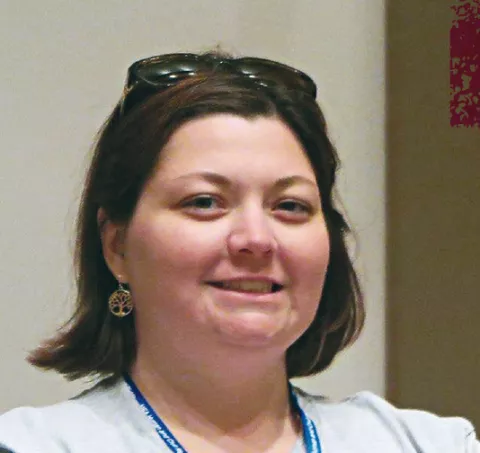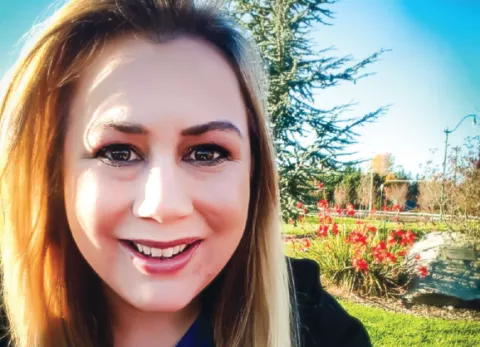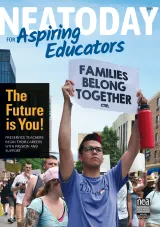It’s a well-known fact that many public school teachers enter the profession only to leave within their first two years of teaching. The U.S. Census Bureau says teachers are leaving the profession at a rate that has continued to climb for the past three years.

First-grade teacher Michelle Usher is staying. Currently in her 11th year of teaching, and her second year at Brentfield Elementary School in Dallas, Texas, Usher says she considered the statistics on teachers who leave while she at- tended last summer’s NEA Representative Assembly, wondering, “Why aren’t we also talking about the people like me who stay?”
Her musings inspired this NEA Today article about the motivations behind a teacher who stays and three college students who want to become teachers. Here are their stories:
Usher was raised by a mom who this year entered her 39th year as an educator. But it was really her third-grade teacher, Robin Johnson—with whom Usher continues to maintain contact— who inspired her to teach.
While Usher was in Johnson’s class, her grandmother died. “It was really hard on me,” Usher says. Johnson assured her they would weather Usher’s grief together.
Johnson’s support led Usher to understand early that teachers provide more than academic instruction. They also provide care—the lesson Usher says she most wants her students to receive: “I’m not just here to teach you something. I really care about you.”
Usher says students enter school carrying with them an invisible suitcase filled with whatever is going on in their life, and they can’t set it aside. “Even though I don’t know what’s going on, I help them unpack their suitcase.” At day’s end, she helps pack it back up, hoping that she has helped to make the contents a bit “fluffier and brighter.”
And that’s why she remains. “I stay because I want to make change. Even when I started teaching, there were laws and policy procedures that didn’t fit with what is actually happening in the classroom. I could have left five years ago, but my drive is if I keep teaching in the class- room, keep talking to parents, we can get the votes we need.
“I think now, we are seeing what we decided earlier isn’t going to work. That’s a big reason why I stay. If I can impact students every day, teach them how government works, I am impacting what we will see in 20 years.”
While the next generation of educators are still in preservice, many have chosen the profession because they—like Usher—have been inspired to teach, and they’re using their student chapters and associations as a stepping stone to become great teachers.
THE NEXT GENERATION

Taylor Davila is a career changer. She worked in healthcare before deciding to take after her teacher mom. Today, Davila is a senior at Western Governors University in Washington, majoring in Interdisciplinary Studies, Elementary Education (K–8). Growing up, she identified as gifted so it was easy for some teachers to give her more challenging work and then walk away. But “the ones who connected with me made a profound impact on me and continue—to this day—to engage in my learning,” she says. And that is the kind of educator she aspires to become. “I’ve just seen through student teaching the power of creating student connections before getting them engaged and spark- ing their interest in learning.”
The NEA Aspiring Educators program has helped Davila make her own networks, too. “I really like that I’m able to connect with students from different universities, different ages and backgrounds, as well as practicing educators.
That’s really important because I learn a lot from everyone.” And NEA Aspiring Educators allows her to do just that because “without it how would I connect with my peers?” she muses.
For Qohle Grey Martinez, a political science major at Fresno City College, the path toward the profession resembles that of the mythological phoenix that arose from ashes. During the Great Recession more than 10 years ago Qohle’s family—like many across the country—was hit hard by the housing market crash. Qohle was in middle school and says he went through “a very rough time.” He says his best friend, Zach- ary Fonteyn “was there for me, and in a way mentored me back to a happy life. I wanted to become to other people what he was to me: a teacher!” Qohle enrolled in political science and within his first week joined his local chapter, the Student California Teachers Association (CTA).
His involvement with Student CTA solidified his career path.
Qohle met like-minded aspiring educators within his local, and across the country, who helped him realize that activism stretches beyond California. “I found so many amazing aspiring educators who were just like me! And, we were now a part of something bigger—we were a union family.”

“It’s in my blood,” says Liann Sanerivi about teaching. She’s a special education and elementary education major at the University of Hawaii - West Oahu. Both of her parents were teachers—along with other family members—and she fondly recalls spending much of her childhood helping them in their classrooms. Early on, she also worked with special education students to help them with their social skills. “The longer I did that, the more I realized this is what I was meant to do and what I was supposed to do with the rest of my life,” says Sanerivi.
She says the leaders and members of the Hawaii State Teachers Association Student Program and NEA Aspiring Educators have helped her embrace opportunities for growth. “They understand we are the future of education and there are so many tips and tricks they pass down to me so that I’m not burned out by year three. My teaching practice will forever be changed to remember that I don’t have to do it alone, and that guidance alone is priceless.”



